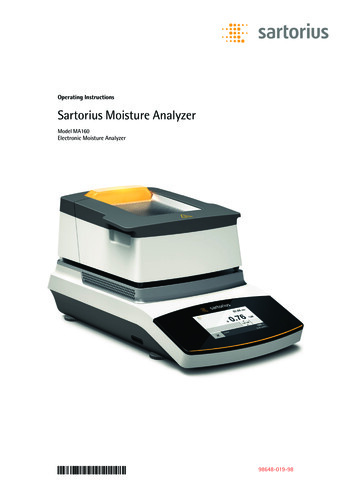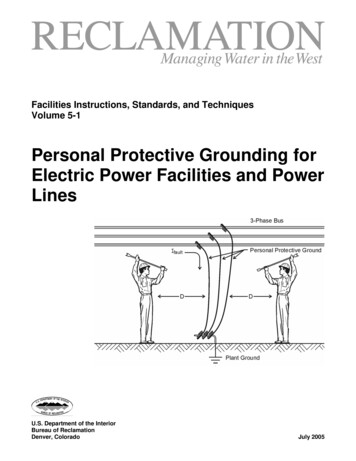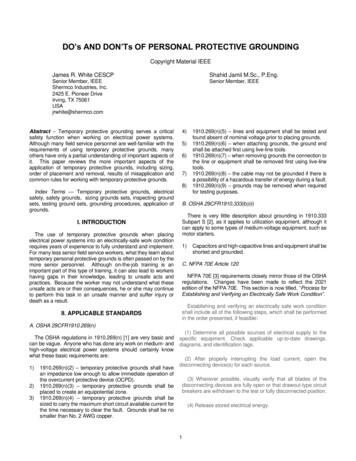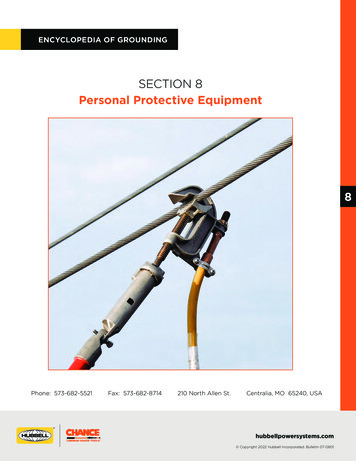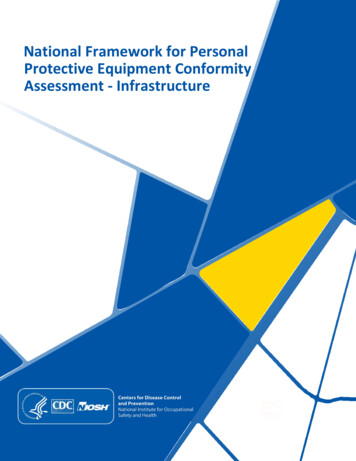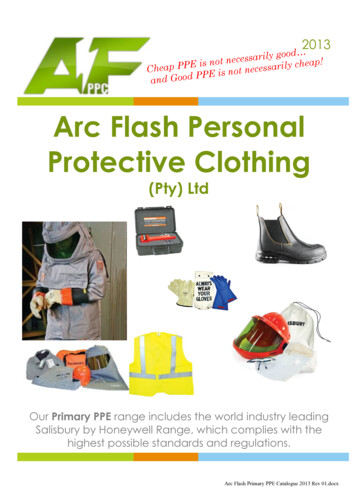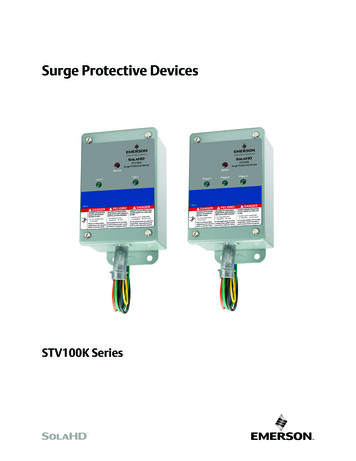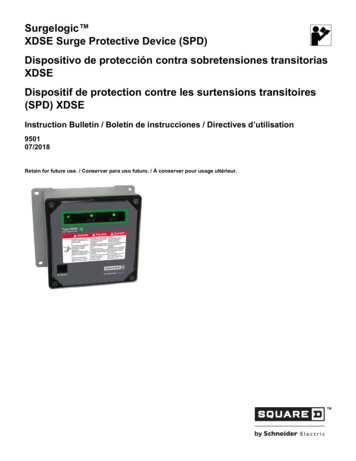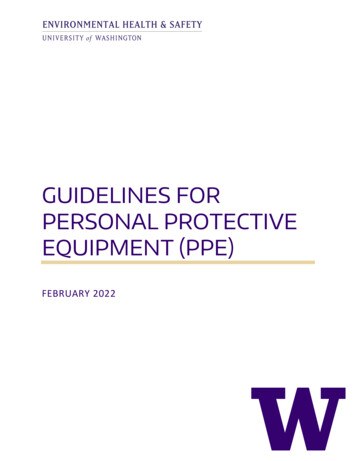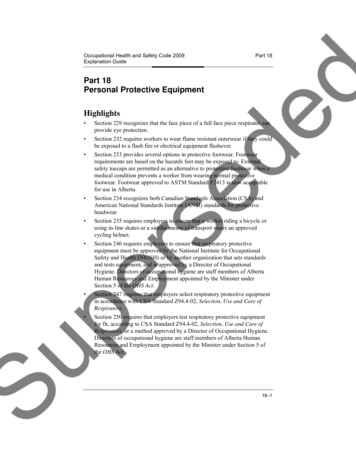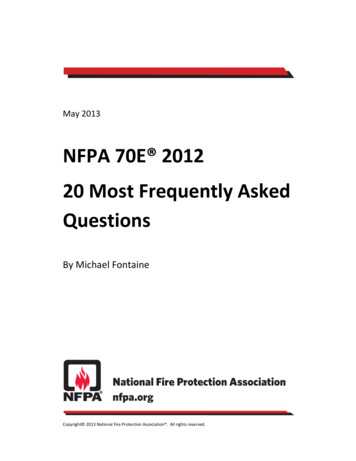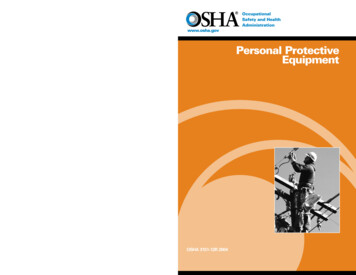
Transcription
Personal ProtectiveEquipmentOSHA 3151-12R 2004
Personal ProtectiveEquipmentU.S. Department of LaborOccupational Safety and Health AdministrationOSHA 3151-12R2004
Employers are responsible for providing asafe and healthy workplace for their employees.OSHA’s role is to promote the safety and healthof America’s working men and women bysetting and enforcing standards; providingtraining, outreach and education; establishing partnerships; and encouraging continualimprovement in workplace safety and health.This publication provides a general overviewof a particular standards-related topic. Thispublication does not alter or determine compliance responsibilities which are set forth inOSHA standards, and the Occupational Safetyand Health Act of 1970. Moreover, becauseinterpretations and enforcement policy maychange over time, for additional guidance onOSHA compliance requirements the readershould consult current OSHA administrativeinterpretations and decisions by the Occupational Safety and Health Review Commissionand the courts.Material contained in this publication is in thepublic domain and may be reproduced, fullyor partially, without permission. Source creditis requested but not required.This information is available to sensoryimpaired individuals upon request. Voicephone: (202) 693-1999; teletypewriter (TTY)number: (877) 889-5627.
ContentsIntroduction.4The Requirement for PPE.5The Hazard Assessment.6Selecting PPE.8Training Employees in the Proper Use of PPE.9Eye and Face Protection.9Prescription Lenses.10Eye Protection for Exposed Employees.10Types of Eye Protection.11Welding Operations.12Laser Operations.16Head Protection.16Types of Hard Hats.18Size and Care Considerations.18Foot and Leg Protection.19Special Purpose Shoes.21Foundry Shoes.22Care of Protective Footwear.22Hand and Arm Protection.22Types of Protective Gloves.23Leather, Canvas or Metal Mesh Gloves.23Fabric and Coated Fabric Gloves.24Chemical- and Liquid-Resistant Gloves.24Care of Protective Gloves.29Body Protection.29Hearing Protection.302
OSHA Assistance.32Safety and Health Program Management Guidelines.33State Programs.33Consultation Services.34Voluntary Protection Programs (VPP).34Strategic Partnership Program.35Alliance Program.35OSHA Training and Education.36Information Available Electronically.36OSHA Publications.37Contacting OSHA.37OSHA Regional Offices.38List of TablesTable 1:Filter Lenses for Protection Against Radiant Energy.13Table 2:Construction Industry Requirements for Filter Lens ShadeNumbers for Protection Against Radiant Energy.15Table 3:Selecting Laser Safety Glass.16Table 4:Chemical Resistance Selection Chart for ProtectiveGloves.26Table 5:Permissible Noise Exposures.31Appendix A: OSHA Standards that Require PPE.403
IntroductionHazards exist in every workplace in many different forms: sharpedges, falling objects, flying sparks, chemicals, noise and a myriadof other potentially dangerous situations. The Occupational Safetyand Health Administration (OSHA) requires that employers protecttheir employees from workplace hazards that can cause injury.Controlling a hazard at its source is the best way to protectemployees. Depending on the hazard or workplace conditions,OSHA recommends the use of engineering or work practicecontrols to manage or eliminate hazards to the greatest extentpossible. For example, building a barrier between the hazard andthe employees is an engineering control; changing the way inwhich employees perform their work is a work practice control.When engineering, work practice and administrative controls arenot feasible or do not provide sufficient protection, employers mustprovide personal protective equipment (PPE) to their employeesand ensure its use. Personal protective equipment, commonlyreferred to as “PPE”, is equipment worn to minimize exposure to avariety of hazards. Examples of PPE include such items as gloves,foot and eye protection, protective hearing devices (earplugs,muffs) hard hats, respirators and full body suits.This guide will help both employers and employees do thefollowing:nUnderstand the types of PPE.nnnKnow the basics of conducting a “hazard assessment” of theworkplace.Select appropriate PPE for a variety of circumstances.Understand what kind of training is needed in the proper useand care of PPE.The information in this guide is general in nature and does notaddress all workplace hazards or PPE requirements. The information,methods and procedures in this guide are based on the OSHArequirements for PPE as set forth in the Code of Federal Regulations(CFR) at 29 CFR 1910.132 (General requirements); 29 CFR 1910.133(Eye and face protection); 29 CFR 1910.135 (Head protection); 29 CFR1910.136 (Foot protection); 29 CFR 1910.137 (Electrical protectiveequipment); 29 CFR 1910.138 (Hand protection); and regulationsthat cover the construction industry, at 29 CFR 1926.95 (Criteria4
for personal protective equipment); 29 CFR 1926.96 (Occupationalfoot protection); 29 CFR 1926.100 (Head protection); 29 CFR 1926.101(Hearing protection); and 29 CFR 1926.102 (Eye and face protection);and for the maritime industry at 29 CFR 1915.152 (General requirements); 29 CFR 1915.153 (Eye and face protection); 29 CFR 1915.155(Head protection); 29 CFR 1915.156 (Foot protection); and 29 CFR1915.157 (Hand and body protection).This guide does not address PPE requirements relatedto respiratory protection (29 CFR 1910.134). There is a briefdiscussion of hearing protection in this publication but usersshould refer to OSHA Publication 3074, “Hearing Conservation”for more detailed information on the requirements to protectemployees’ hearing in the workplace.The Requirement for PPETo ensure the greatest possible protection for employees inthe workplace, the cooperative efforts of both employers andemployees will help in establishing and maintaining a safe andhealthful work environment.In general, employers are responsible for:nPerforming a “hazard assessment” of the workplace to identifyand control physical and health hazards.nIdentifying and providing appropriate PPE for employees.nTraining employees in the use and care of the PPE.nMaintaining PPE, including replacing worn or damaged PPE.nnPeriodically reviewing, updating and evaluating the effectiveness of the PPE program.In general, employees should:Properly wear PPE,nAttend training sessions on PPE,nCare for, clean and maintain PPE, andnInform a supervisor of the need to repair or replace PPE.Specific requirements for PPE are presented in many differentOSHA standards, published in 29 CFR. Some standards require that5
employers provide PPE at no cost to the employee while otherssimply state that the employer must provide PPE. Appendix A atpage 40 lists those standards that require the employer to providePPE and those that require the employer to provide PPE at no costto the employee.In a final rule on employer-paid PPE published in November2007, all PPE, with a few exceptions, will be provided at no costto the employee. The Nov. 2007 final rule also clarified OSHA’srequirements regarding payment for employee-owned PPE andfor replacement PPE. The final rule is published at 72 Fed. Reg.64341-64430 (Nov. 15, 2007).The Hazard AssessmentA first critical step in developing a comprehensive safety andhealth program is to identify physical and health hazards in theworkplace. This process is known as a “hazard assessment.”Potential hazards may be physical or health-related and a comprehensive hazard assessment should identify hazards in bothcat-egories. Examples of physical hazards include moving objects,fluctuating temperatures, high intensity lighting, rolling or pinchingobjects, electrical connections and sharp edges. Examples of healthhazards include overexposure to harmful dusts, chemicals orradiation.The hazard assessment should begin with a walkthrough surveyof the facility to develop a list of potential hazards in the followingbasic hazard categories:nImpact,nPenetration,nCompression (roll-over),nChemical,nHeat/cold,nHarmful dust,nLight (optical) radiation, andnBiologic.In addition to noting the basic layout of the facility andreviewing any history of occupational illnesses or injuries, things6
to look for during the walkthrough survey include:nSources of electricity.nnSources of motion such as machines or processes wheremovement may exist that could result in an impact betweenpersonnel and equipment.Sources of high temperatures that could result in burns, eyeinjuries or fire.nTypes of chemicals used in the workplace.nSources of harmful dusts.nSources of light radiation, such as welding, brazing, cutting,furnaces, heat treating, high intensity lights, etc.nThe potential for falling or dropping objects.nSharp objects that could poke, cut, stab or puncture.nBiologic hazards such as blood or other potentially infectedmaterial.When the walkthrough is complete, the employer shouldorganize and analyze the data so that it may be efficiently usedin determining the proper types of PPE required at the worksite.The employer should become aware of the different types of PPEavailable and the levels of protection offered. It is definitely a goodidea to select PPE that will provide a level of protection greater thanthe minimum required to protect employees from hazards.The workplace should be periodically reassessed for anychanges in conditions, equipment or operating procedures thatcould affect occupational hazards. This periodic reassessmentshould also include a review of injury and illness records to spotany trends or areas of concern and taking appropriate correctiveaction. The suitability of existing PPE, including an evaluation of itscondition and age, should be included in the reassessment.Documentation of the hazard assessment is required through awritten certification that includes the following information:nIdentification of the workplace evaluated;nName of the person conducting the assessment;nDate of the assessment; andnIdentification of the document certifying completion of thehazard assessment.7
Selecting PPEAll PPE clothing and equipment should be of safe design andconstruction, and should be maintained in a clean and reliablefashion. Employers should take the fit and comfort of PPE into consideration when selecting appropriate items for their workplace.PPE that fits well and is comfortable to wear will encourageemployee use of PPE. Most protective devices are available inmultiple sizes and care should be taken to select the proper size foreach employee. If several different types of PPE are worn together,make sure they are compatible. If PPE does not fit properly, it canmake the difference between being safely covered or dangerouslyexposed. It may not provide the level of protection desired and maydiscourage employee use.OSHA requires that many categories of PPE meet or beequivalent to standards developed by the American NationalStandards Institute (ANSI). ANSI has been preparing safetystandards since the 1920s, when the first safety standard wasapproved to protect the heads and eyes of industrial workers.Employers who need to provide PPE in the categories listed belowmust make certain that any new equipment procured meets the citedANSI standard. Existing PPE stocks must meet the ANSI standard ineffect at the time of its manufacture or provide protection equivalentto PPE manufactured to the ANSI criteria. Employers should informemployees who provide their own PPE of the employer’s selectiondecisions and ensure that any employee-owned PPE used in theworkplace conforms to the employer’s criteria, based on the hazardassessment, OSHA requirements and ANSI standards. OSHArequires PPE to meet the following ANSI standards:nEye and Face Protection: ANSI Z87.1-1989 (USA Standard forOccupational and Educational Eye and Face Protection).nHead Protection: ANSI Z89.1-1986.nFoot Protection: ANSI Z41.1-1991.For hand protection, there is no ANSI standard for gloves butOSHA recommends that selection be based upon the tasks to beperformed and the performance and construction characteristics ofthe glove material. For protection against chemicals, glove selection8
must be based on the chemicals encountered, the chemicalresistance and the physical properties of the glove material.Training Employees in the Proper Use of PPEEmployers are required to train each employee who must usePPE. Employees must be trained to know at least the following:nWhen PPE is necessary.nWhat PPE is necessary.nHow to properly put on, take off, adjust and wear the PPE.nThe limitations of the PPE.nProper care, maintenance, useful life and disposal of PPE.Employers should make sure that each employee demonstrates an understanding of the PPE training as well as the abilityto properly wear and use PPE before they are allowed to performwork requiring the use of the PPE. If an employer believes thata previously trained employee is not demonstrating the properunderstanding and skill level in the use of PPE, that employeeshould receive retraining. Other situations that require additionalor retraining of employees include the following circumstances:changes in the workplace or in the type of required PPE that makeprior training obsolete.The employer must document the training of each employeerequired to wear or use PPE by preparing a certification containingthe name of each employee trained, the date of training and a clearidentification of the subject of the certification.Eye and Face ProtectionEmployees can be exposed to a large number of hazards thatpose danger to their eyes and face. OSHA requires employers toensure that employees have appropriate eye or face protectionif they are exposed to eye or face hazards from flying particles,molten metal, liquid chemicals, acids or caustic liquids, chemicalgases or vapors, potentially infected material or potentially harmfullight radiation.9
Many occupational eye injuries occur because employees arenot wearing any eye protection while others result from wearingimproper or poorly fitting eye protection. Employers must be surethat their employees wear appropriate eye and face protection andthat the selected form of protection is appropriate to the work beingperformed and properly fits each employee exposed to the hazard.Prescription LensesEveryday use of prescription corrective lenses will not provideadequate protection against most occupational eye and facehazards, so employers must make sure that employees withcorrective lenses either wear eye protection that incorporates theprescription into the design or wear additional eye protection overtheir prescription lenses. It is important to ensure that the protectiveeyewear does not disturb the proper positioning of the prescriptionlenses so that the employee’s vision will not be inhibited or limited.Also, employees who wear contact lenses must wear eye or facePPE when working in hazardous conditions.Eye Protection for Exposed EmployeesOSHA suggests that eye protection be routinely considered for useby carpenters, electricians, machinists, mechanics, millwrights, plumbersand pipefitters, sheetmetal employees and tinsmiths, assemblers,sanders, grinding machine operators, sawyers, welders, laborers,chemical pro-cess operators and handlers, and timber cutting andlogging workers. Employers of employees in other job categoriesshould decide whether there is a need for eye and face PPE through ahazard assessment.Examples of potential eye or face injuries include:nDust, dirt, metal or wood chips entering the eye from activitiessuch as chipping, grinding, sawing, hammering, the use ofpower tools or even strong wind forces.nnn10Chemical splashes from corrosive substances, hot liquids,solvents or other hazardous solutions.Objects swinging into the eye or face, such as tree limbs, chains,tools or ropes.Radiant energy from welding, harmful rays from the use oflasers or other radiant light (as well as heat, glare, sparks, splashand flying particles).
Types of Eye ProtectionSelecting the most suitable eye and face protection foremployees should take into consideration the following elements:nAbility to protect against specific workplace hazards.nShould fit properly and be reasonably comfortable to wear.nShould provide unrestricted vision and movement.nShould be durable and cleanable.nShould allow unrestricted functioning of any other required PPE.The eye and face protection selected for employee use mustclearly identify the manufacturer. Any new eye and face protectivedevices must comply with ANSI Z87.1-1989 or be at least aseffective as this standard requires. Any equipment purchasedbefore this requirement took effect on July 5, 1994, must complywith the earlier ANSI Standard (ANSI Z87.1-1968) or be shown tobe equally effective.An employer may choose to provide one pair of protectiveeyewear for each position rather than individual eyewear foreach employee. If this is done, the employer must make sure thatemployees disinfect shared protective eyewear after each use.Protective eyewear with corrective lenses may only be used by theemployee for whom the corrective prescription was issued andmay not be shared among employees.Some of the most common types of eye and face protectioninclude the following:nSafety spectacles. These protective eyeglasses have safetyframes constructed of metal or plastic and impact-resistantlenses. Side shields are available on some models.nnGoggles. These are tight-fitting eye protection that completelycover the eyes, eye sockets and the facial area immediatelysurrounding the eyes and provide protection from impact, dustand splashes. Some goggles will fit over corrective lenses.Welding shields. Constructed of vulcanized fiber or fiberglassand fitted with a filtered lens, welding shields protect eyes fromburns caused by infrared or intense radiant light; they alsoprotect both the eyes and face from flying sparks, metal spatterand slag chips produced during welding, brazing, soldering and11
cutting operations. OSHA requires filter lenses to have a shadenumber appropriate to protect against the specific hazards ofthe work being performed in order to protect against harmfullight radiation.nnLaser safety goggles. These specialty goggles protect againstintense concentrations of light produced by lasers. The type oflaser safety goggles an employer chooses will depend upon theequipment and operating conditions in the workplace.Face shields. These transparent sheets of plastic extend fromthe eyebrows to below the chin and across the entire width ofthe employee’s head. Some are polarized for glare protection.Face shields protect against nuisance dusts and potentialsplashes or sprays of hazardous liquids but will not provideadequate protection against impact hazards. Face shields usedin combination with goggles or safety spectacles will provideadditional protection against impact hazards.Each type of protective eyewear is designed to protect againstspecific hazards. Employers can identify the specific workplacehazards that threaten employees’ eyes and faces by completing ahazard assessment as outlined in the earlier section.Welding OperationsThe intense light associated with welding operations can causeserious and sometimes permanent eye damage if operators do notwear proper eye protection. The intensity of light or radiant energyproduced by welding, cutting or brazing operations varies accordingto a number of factors including the task producing the light, theelectrode size and the arc current. The following table shows theminimum protective shades for a variety of welding, cutting andbrazing operations in general industry and in the shipbuildingindustry.12
Table 1Filter Lenses for Protection Against Radiant EnergyOperationsElectrode size in Arc currentMinimum*1/32” (0.8mm)protectiveshadeShielded metalarc welding 33-55-8 8 6060 - 160160 - 250250 - 550781011Gas metal arc weldingand flux coredarc welding 6060 - 160160 - 250250 - 5007101010Gas tungstenarc welding 5050 - 150150 - 5008810Air carbon(light) 50010Arc cutting(heavy)500 - 1,00011Plasma arc welding 2020 - 100100 - 400400 - 800681011Plasma arc cutting 300300 - 400400 - 8008910(light)**(medium)**(heavy)**Torch brazing3Torch soldering2Carbon arc welding1413
Table 1 (continued)Filter Lenses for Protection Against Radiant EnergyOperationsPlate thicknessinchesPlate thickness Minimum*mmprotectiveshadeGas welding:Light 1/8 3.24Gas welding:Medium1/8 - 1/23.2 - 12.75Gas welding:Heavy 1/2 12.76Oxygen cutting:Light 1 253Oxygen cutting:Medium1-625 - 1504Oxygen cutting:Heavy 6 1505Source: 29 CFR 1910.133(a)(5).* As a rule of thumb, start with a shade that is too dark to see the weldzone. Then go to a lighter shade which gives sufficient view of the weldzone without going below the minimum. In oxyfuel gas welding orcutting where the torch produces a high yellow light, it is desirable touse a filter lens that absorbs the yellow or sodium line in the visible lightof the (spectrum) operation.** These values apply where the actual arc is clearly seen. Experiencehas shown that lighter filters may be used when the arc is hidden by theworkpiece.14
The construction industry has separate requirements for filterlens protective levels for specific types of welding operations, asindicated in the table below:Table 2Construction Industry Requirements for Filter Lens ShadeNumbers for Protection Against Radiant EnergyWelding OperationShade NumberShielded metal-arc welding1/16-, 3/32-, 1/8-, 5/32-inch diameter electrodes10Gas-shielded arc welding (nonferrous)1/16-, 3/32-, 1/8-, 5/32-inch diameter electrodes11Gas-shielded arc welding (ferrous)1/16-, 3/32-, 1/8-, 5/32-inch diameter electrodes12Shielded metal-arc welding3/16-, 7/32-, 1/4-inch diameter electrodes125/16-, 3/8-inch diameter electrodes14Atomic hydrogen welding10 - 14Carbon-arc welding14Soldering2Torch brazing3 or 4Light cutting, up to 1 inch3 or 4Medium cutting, 1 to 6 inches4 or 5Heavy cutting, more than 6 inches5 or 6Gas welding (light), up to 1/8-inch4 or 5Gas welding (medium), 1/8- to 1/2-inch5 or 6Gas welding (heavy), more than 1/2-inch6 or 8Source: 29 CFR 1926.102(b)(1).15
Laser OperationsLaser light radiation can be extremely dangerous to theunprotected eye and direct or reflected beams can causepermanent eye damage. Laser retinal burns can be painless, soit is essential that all personnel in or around laser operationswear appropriate eye protection.Laser safety goggles should protect for the specific wavelengthof the laser and must be of sufficient optical density for the energyinvolved. Safety goggles intended for use with laser beams mustbe labeled with the laser wavelengths for which they are intendedto be used, the optical density of those wavelengths and the visiblelight transmission.The table below lists maximum power or energy densities andappropriate protection levels for optical densities 5 through 8.Table 3Selecting Laser Safety GlassIntensity, CW maximumpower density (watts/cm2)AttenuationOptical densityAttenuation(O.D.)factor10 -2510510 -161061.0710710.08108Source: 29 CFR 1926.102(b)(2).Head ProtectionProtecting employees from potential head injuries is a keyelement of any safety program. A head injury can impair anemployee for life or it can be fatal. Wearing a safety helmet orhard hat is one of the easiest ways to protect an employee’s head16
from injury. Hard hats can protect employees from impact andpenetration hazards as well as from electrical shock and burnhazards.Employers must ensure that their employees wear headprotection if any of the following apply:nObjects might fall from above and strike them on the head;nnThey might bump their heads against fixed objects, such asexposed pipes or beams; orThere is a possibility of accidental head contact with electricalhazards.Some examples of occupations in which employees should berequired to wear head protection include construction workers,carpenters, electricians, linemen, plumbers and pipefitters, timberand log cutters, welders, among many others. Whenever thereis a danger of objects falling from above, such as working belowothers who are using tools or working under a conveyor belt, headprotection must be worn. Hard hats must be worn with the billforward to protect employees properly.In general, protective helmets or hard hats should do thefollowing:nResist penetration by objects.nAbsorb the shock of a blow.nBe water-resistant and slow burning.nHave clear instructions explaining proper adjustment andreplacement of the suspension and headband.Hard hats must have a hard outer shell and a shock-absorbinglining that incorporates a headband and straps that suspend theshell from 1 to 1 1/4 inches (2.54 cm to 3.18 cm) away from thehead. This type of design provides shock absorption during animpact and ventilation during normal wear.Protective headgear must meet ANSI Standard Z89.1-1986(Protective Headgear for Industrial Workers) or provide anequivalent level of protection. Helmets purchased before July 5,1994 must comply with the earlier ANSI Standard (Z89.1-1969)or provide equivalent protection.17
Types of Hard HatsThere are many types of hard hats available in the marketplacetoday. In addition to selecting protective headgear that meets ANSIstandard requirements, employers should ensure that employeeswear hard hats that provide appropriate protection against potentialworkplace hazards. It is important for employers to understand allpotential hazards when making this selection, including electricalhazards. This can be done through a comprehensive hazardanalysis and an awareness of the different types of protectiveheadgear available.Hard hats are divided into three industrial classes:nClass A hard hats provide impact and penetration resistancealong with limited voltage protection (up to 2,200 volts).nnClass B hard hats provide the highest level of protection againstelectrical hazards, with high-voltage shock and burn protection(up to 20,000 volts). They also provide protection from impactand penetration hazards by flying/falling objects.Class C hard hats provide lightweight comfort and impactprotection but offer no protection from electrical hazards.Another class of protective headgear on the market is called a“bump hat,” designed for use in areas with low head clearance.They are recommended for areas where protection is needed fromhead bumps and lacerations. These are not designed to protectagainst falling or flying objects and are not ANSI approved. It isessential to check the type of hard hat employees are using toensure that the equipment provides appropriate protection. Eachhat should bear a label inside the shell that lists the manufacturer,the ANSI designation and the class of the hat.Size and Care ConsiderationsHead protection that is either too large or too small is inappropriate for use, even if it meets all other requirements. Protectiveheadgear must fit appropriately on the body and for the head sizeof each individual. Most protective headgear comes in a varietyof sizes with adjustable headbands to ensure a proper fit (manyadjust in 1/8-inch increments). A proper fit should allow sufficientclearance between the shell and the suspension system for18
ventilation and distribution of an impact. The hat should not bind,slip, fall off or irritate the skin.Some protective headgear allows for the use of variousac-cessories to help employees deal with changing environmentalconditions, such as slots for earmuffs, safety glasses, face shieldsand mounted lights. Optional brims may provide additionalprotection from the sun and some hats have channels that guiderainwater away from the face. Protective headgear accessoriesmust not compromise the safety elements of the equipment.Periodic cleaning and inspection will extend the useful lifeof protective headgear. A daily inspection of the hard hat shell,sus-pension system and other accessories for holes, cracks, tearsor other damage that might compromise the protective value of thehat is essential. Paints, paint thinners and some cleaning agentscan weaken the shells of hard hats and may eliminate electricalre-sistance. Consult the helmet manufacturer for information onthe effects of paint and cleaning materials on their hard hats. Neverdrill holes, paint or apply labels to protective headgear as thismay reduce the integrity of the protection. Do not store protectiveheadgear in direct sunlight, such as on the rear window shelf of acar, since sunlight and extreme heat can damage them.Hard hats with any of the following defects should be removedfrom service and replaced:nPerforation, cracking, or deformity of the brim or shell;nIndication of exposure of the brim or shell to heat, chemicalsor ultraviolet light and other radiation (in addition to a loss ofsurface gloss, such signs include chalking or flaking).Always replace a hard hat if it sustains an impact, even ifdamage is not noticeable. Suspension systems are offered asreplacement parts and should be replaced when damaged or whenexcessive wear is noticed. It is not necessary to replace the entirehard hat when deterioration or tears of the suspension systems arenoticed.Foot and Leg ProtectionEmployees who face possible foot or leg injuries from fallingor rolling objects or from crushing or penetrating materials should19
wear protective footwear. Also, employees whose work involvesexposure to hot substances or corrosive or poisonous materialsmust have protective gear to cover exposed body parts, includinglegs and feet. If an employee’s feet may be exposed to electricalhazards, non-conductive footwear should be worn. On the otherhand, workplace exposure to static electricity may necessitate theuse of conductive footwear.Examples of situations in which an employee should wear footand/or leg protection include:nWhen heavy objects such as barrels or tools might roll onto orfall on the employee’s feet;nWorking with s
Personal protective equipment, commonly referred to as “PPE”, is equipment worn to minimize exposure to a variety of hazards. Examples of PPE include such items as gloves, foot and eye protection, protective hearing devices (ear
